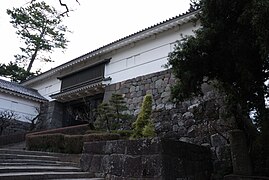Odawara Castle
| Odawara-jō | ||
|---|---|---|
|
Odawara Castle, castle tower |
||
| Creation time : | around 1400 | |
| Castle type : | Hill castle | |
| Conservation status: | partially preserved | |
| Place: | Odawara | |
| Geographical location | 35 ° 15 '3.8 " N , 139 ° 9' 12.4" E | |
|
|
||
The Castle Odawara ( Japanese 小田原城 , Odawara-jō ) is a castle in the city of Odawara in Kanagawa Prefecture in Japan . Most recently the Ōkubo resided there, who with an income of 103,000 koku belonged to the larger Fudai daimyo .
Lords of the castle in the Edo period
history
The castle is said to have been created in the Kamakura period by Dohi Tōhira (土肥 遠 平; † 1237). In 1416 Ōmori Yoriharu became lord of the castle. However, his son Fujiyori was replaced in 1495 by Hōjō Sōun from Izu Province . Thereafter, four generations of the later Hōjō were lords of the castle and took parts of the Kantō plain in possession.
The extensive defenses and trenches allowed a successful defense against great warriors such as Uesugi Kenshin and Takeda Shingen . Toyotomi Hideyoshi then advanced with an army of 210,000 soldiers, but took the castle in 1590 after 6 months of siege after the defenders debated for days ( advice from Odawara ). Hideyoshi gave Kantō area to Tokugawa Ieyasu , who had to give up his old areas further west. Ieyasu installed his important vassal Okubo Tadayo (大 久保 忠 世) in Odawara.
When it was built, the castle was on a hill between the Sakawa River (酒 匂 川, Sakawa-gawa) in the east and the Hayakawa (早川) in the west. On a top of the Hachiman Mountain (八 幡 山, Hachiman-yama). In the Edo period , the castle had the central area, the Hommaru, to which the second district, the Ni-no-maru, in the east; connected. In the south, the fortified areas, the Koya-guruwa (小屋 曲 輪) and the Takabuya-guruwa (鷹 部屋 曲 輪) joined. In the south-east protected the areas Umaya-guruwa (馬 屋 曲 輪) and Chatsubo-guruwa (茶 壷 曲 輪) and in the north the Benten-guruwa (弁 天 曲 輪). In 1632 and 1782 earthquakes damaged the castle.
In the Edo period , Odawara's convenient location on the old Tōkaidō road between the mountainous Hakone and Sagami Bay gave the castle a special strategic importance. During the Edo period, the castle controlled the Tōkaidō between the headquarters of the Tokugawa Shogunate in Edo and the stations west of Hakone, such as Sumpu ( Shizuoka ), Hamamatsu and Nagoya .
Today the castle district has been transformed into a park, the Odawarajō-ato kōen (小田原 城 址 公園). The base of the castle tower and the stone walls of the Hommaru, the Ni-no-maru, Umaya-guruwa, and Minami-guruwa have been preserved. In 1960 the outer appearance of the castle tower was rebuilt from reinforced concrete. In recent years gates, the Tokiwagi-mon (常 盤 木門) and the Akagane-mon (銅門), have been restored.
photos
literature
- Tsutsui, Yasuo: Odawara-jo in: Miura, Masayuki (ed.): Shiro to jinya. Tokoku-hen. Gakken, 2006. ISBN 978-4-05-604378-5 .






